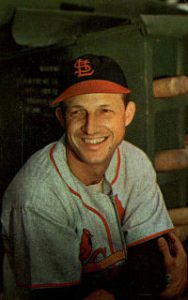
“Stan the Man” would have been proud.
Stan Musial, the St. Louis Cardinals baseball icon known throughout America for his hitting prowess during the 1940s and ‘50s, is remembered for his great humility. So he likely couldn’t have imagined that only seven months after his death in 2013 that a major Mississippi River bridge crossing would be named after the slugging champ.
Originally referred to as “The Mississippi River Bridge Crossing,” the Stan Musial Veterans Memorial Bridge was made possible by the provisions of the Federal Highway Administration’s Buy America Act, which requires infrastructure projects to contain 100 percent American-made steel or iron to receive federal funding.

The Stan Musial Veterans Memorial Bridge — now known as the “Stan Span” in the St. Louis area — proved to be a major success. Completed two months ahead of schedule in February 2014 and approximately $23 million under budget, the bridge created well-paying jobs for more than 3,400 American workers during varying phases of construction by following Buy America provisions.
It’s a model for how major infrastructure projects can (and should) be built in the United States.
“I still even go out of my way to cross the Stan Span when it’s not the most direct path to St. Louis. I live on the Illinois side of the river about 10 minutes from downtown St. Louis,” said Doug May, a crane operator at the nearby U.S. Steel Granite City Works mill who can see the bridge from the cab of his crane. “But if my direct path doesn’t take me across the bridge, I go out of my way to cross it. It’s just that attractive.”
The Stan Span was built to re-route traffic on overly congested Interstate 70, ease traffic on other bridges and highways and help eliminate the surrounding blighted neighborhoods. The aging Poplar Street Bridge had been the passage for three Interstate highways, including I-70, and had become unsafe with many vehicle accidents and road repair delays.
Only three months after opening, the anticipated projections of effectiveness began to materialize like another Musial All-Star Game appearance. The new bridge is accommodating roughly 30,000 cars per day and after seven months, the bridge already reached its projected peak use of 41,000 vehicles daily. The Poplar Street Bridge, formerly the busiest in the area, is handling 20,000 fewer cars per day – a 19 percent daily decrease. Traffic on the nearby Martin Luther King Bridge is down 44 percent.
“We’ve had a lot of feedback on the bridge and people are happy,” project coordinator Randy Hitt said. “They say their commute is 10 or 15 minutes shorter every day. And it’s such a beautiful structure it’s just an added bonus. It’s something people see in the skyline and are pretty proud.”
The bridge — currently the third longest cable-stayed bridge in the United States — also provided St. Louis with another beautiful monument to complement the Gateway Arch in the city’s skyline. It is a stunning structure, especially under the nighttime lights.
It was cited as the winner of the Mid America Regional America’s Transportation Award, conducted annually by the American Association of State Highway and Transportation Officials (AASHTO). The Stan Musial Veterans Memorial Bridge is also one of 2014’s 10 finalists to receive the AASHTO national award in three categories: Best Use of Innovation, Under Budget, and Quality of Life/Community Development.
Building the Bridge
Residents and transportation officials from both Missouri and Illinois knew there was a major need for an updated passage connecting St. Louis with burgeoning St. Clair County in Southern Illinois. But both states lacked sufficient funds to take on this massive project, so state officials applied for federal funding and grants from the Federal Highway Administration (FHWA).
It took intense negotiating by Missouri, Illinois, and federal government officials to set the project in motion. An agreement was reached that required 37 separate contracts – 32 by Illinois, five by Missouri.
Most of the contracts were between Illinois and the FHWA. One of the contracts initiated by Illinois required all workers to be union members and, although such a contract was not required in Missouri, the Missouri contractors decided to hire union employees as well. Small businesses are appearing on the formerly blighted areas creating even more jobs.
Work on the bridge began in 2010 and was completed in early February 2014. The steel for the main span of the bridge —approximately 80 percent — was sourced from AFCO Steel in Little Rock, Ark. A host of smaller steel mills and fabricators throughout the South and Midwest produced the remaining steel, including the cables.
Funding for the Mississippi River Bridge Crossing amounted to $670 million. Of that total, about 80 percent of the funding was used to build the main span and some approaches. Approximately $264 million state funds were used to move I-70 in Illinois, $57 million to relocate I-70 in Missouri and $346 million to build the bridge with FHWA funding.
The total length of the bridge is just 2,803 feet with a main span of 1,500 feet. The bridge is 86 feet wide with cables that stretch from the bridge deck to the tops of two A-shaped towers which reach 435 feet above I-70. Nearly 15,000 tons of structural steel was used along with 8,600 tons of reinforcing steel. More than 90,000 cubic yards of concrete are in the foundation, deck slab and towers.
Something to be Proud Of
Alongside Illinois Gov. Pat Quinn, USW International Vice President Tom Conway attended the Feb. 8 ribbon-cutting ceremony.
“U.S. taxpayer dollars should be used to stimulate U.S.-based jobs within our own borders, and this bridge is the right way to do that,” Conway said.
Quinn expressed his strong support for Buy America, outlining the benefits to our economy:
“Thanks to the hard work of our diverse group of American trade workers, contractors and consulting engineers who made this project happen, motorists on both sides of the river now have a safer, less congested and faster commute. This project’s federal and state government partnership means that American workers, using American materials, made something that will benefit America for decades to come.”
After completion of the Mississippi River Bridge project, a flurry of negotiations took place to decide a permanent name for the aesthetically beautiful bridge that rivals the St. Louis Gateway Arch as a symbol of American ingenuity.
Several petitions were put forward in Illinois to name the span “Veterans Memorial Bridge.” In Missouri, two state senators introduced a bill to name the bridge after Stan Musial, not only a baseball ambassador but a St. Louis community leader. Musial, a Navy veteran, had died only three days earlier.
It seemed a simple compromise was not far off. The bridge was officially named the Stan Musial Veterans Memorial Bridge with the executive signature of President Barack Obama on July 12, 2013.
“Stan Musial had outstanding character and was very engaged in the community,” May said. “He was just a great ambassador for the community and he stood for all the good things in life. So to have it named after him — I thought it was perfect.”
He was known as “Stan the Man” and probably will carry that moniker for many years to come. But, wouldn’t you know, the bridge is already being commonly called “The Stan Span.”
Buy America — it’s American as mom, apple pie and yes, baseball.
